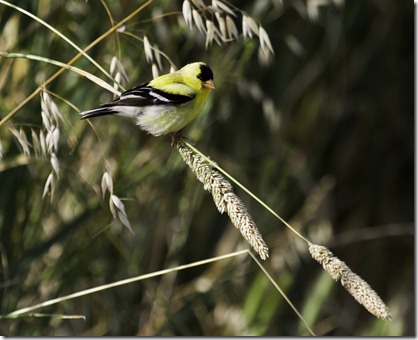Phil’s Photo Monday
American Goldfinch, photo by Phil Robertson
Cool Facts
American Goldfinches are the only finch that molts its body feathers twice a year, once in late winter and again in late summer. The brightening yellow of male goldfinches each spring is one welcome mark of approaching warm months.
American Goldfinches breed later than most North American birds. They wait to nest until June or July when milkweed, thistle, and other plants have produced their fibrous seeds, which goldfinches incorporate into their nests and also feed their young.
Goldfinches are among the strictest vegetarians in the bird world, selecting an entirely vegetable diet and only inadvertently swallowing an occasional insect.
When Brown-headed Cowbirds lay eggs in an American Goldfinch nest, the cowbird egg may hatch but the nestling seldom survives longer than three days. The cowbird chick simply can’t survive on the all-seed diet that goldfinches feed their young.
Goldfinches move south in winter following a pattern that seems to coincide with regions where the minimum January temperature is no colder than 0 degrees Fahrenheit on average.
As of May 2007, the oldest known American Goldfinch was 10 years 5 months old.
Paired-up goldfinches make virtually identical flight calls; goldfinches may be able to distinguish members of various pairs by these calls.
Habitat
Open Woodland
Weedy fields, open floodplains, and other overgrown areas, particularly with sunflower, aster, and thistle plants for food and some shrubs and trees for nesting. Goldfinches are also common in suburbs, parks, and backyards.
Food
Seeds
Goldfinches eat seeds almost exclusively. Main types include seeds from composite plants (in the family Asteraceae: sunflowers, thistle, asters, etc.), grasses, and trees such as alder, birch, western red cedar, and elm. At feeders prefers nyjer and sunflower.
Nesting
Nesting Facts
Clutch Size
2–7 eggs
Number of Broods
1-2 broods
Egg Length
0.6–0.7 in
Egg Width
0.5–0.5 in
Incubation Period
12–14 days
Nestling Period
11–17 days
Egg Description
Pale bluish white, sometimes with small faint brown spots around large end.
Condition at Hatching
Helpless, with wisps of grayish down.
Nest Description
The nest is an open cup of rootlets and plant fibers lined with plant down, often woven so tightly that it can hold water. The female lashes the foundation to supporting branches using spider silk, and makes a downy lining often using the fluffy “pappus” material taken from the same types of seedheads that goldfinches so commonly feed on. It takes the female about 6 days to build the nest. The finished nest is about 3 inches across on the outside and 2-4.5 inches high.
Nest Placement
Shrub
Male and female move around together to choose a suitable nest site. The female builds the nest, usually in a shrub or sapling in a fairly open setting rather than in forest interior. The nest is often built high in a shrub, where two or three vertical branches join; usually shaded by leaves of clusters of needles from above, but often open and visible from below.
Behavior
Foliage Gleaner
American Goldfinches are active, acrobatic finches that balance on the seedheads of thistles, dandelions, and other plants to pluck seeds. They have a bouncy flight during which they frequently make their po-ta-to-chip calls. Although males sing exuberantly during spring, pairs do not nest until mid-summer, when thistles and other weeds have gone to seed. Goldfinches do not join other songbirds mobbing predators.
Source: http://www.allaboutbirds.org/guide/American_Goldfinch/lifehistory

 (916) 434-2759
(916) 434-2759



